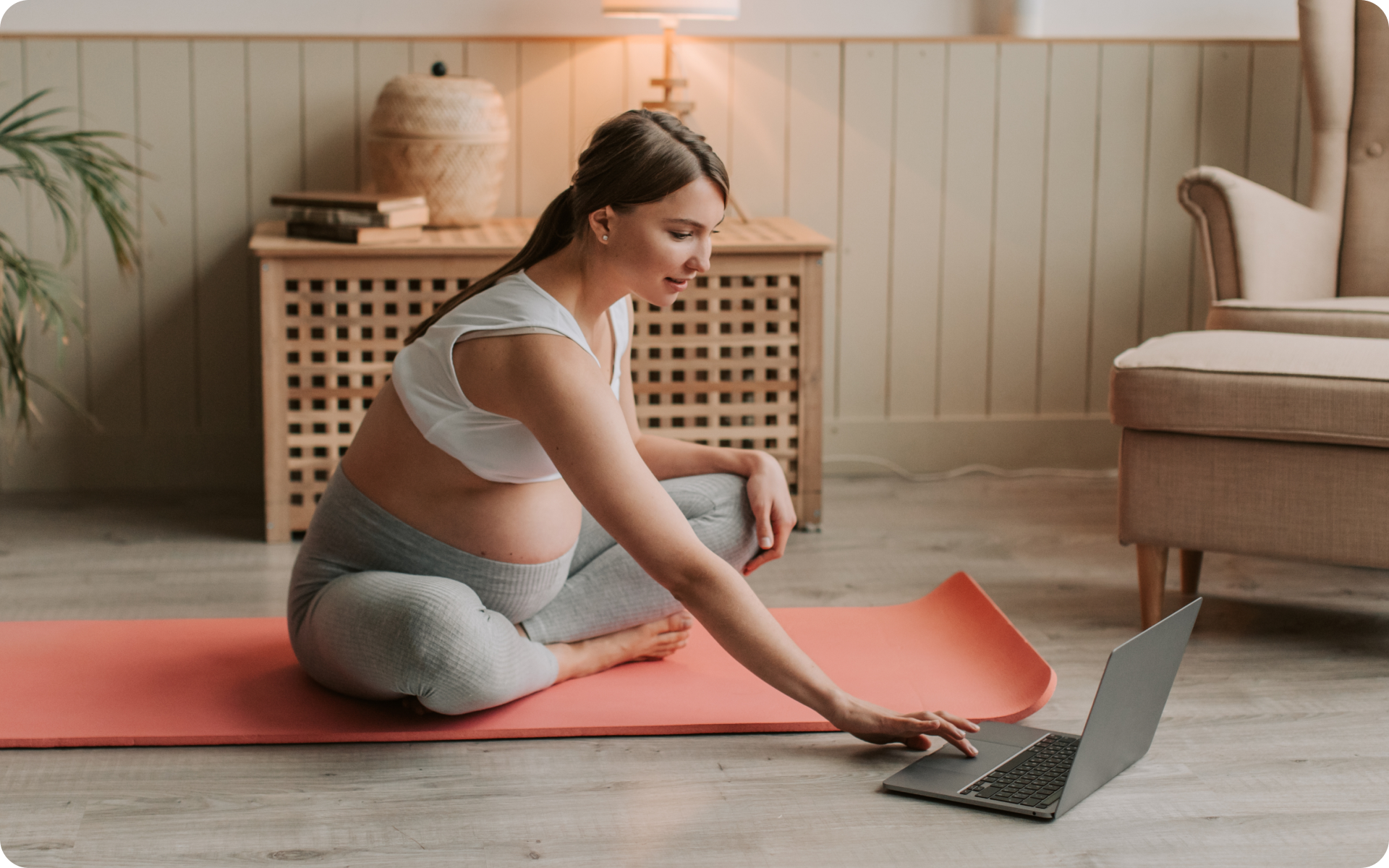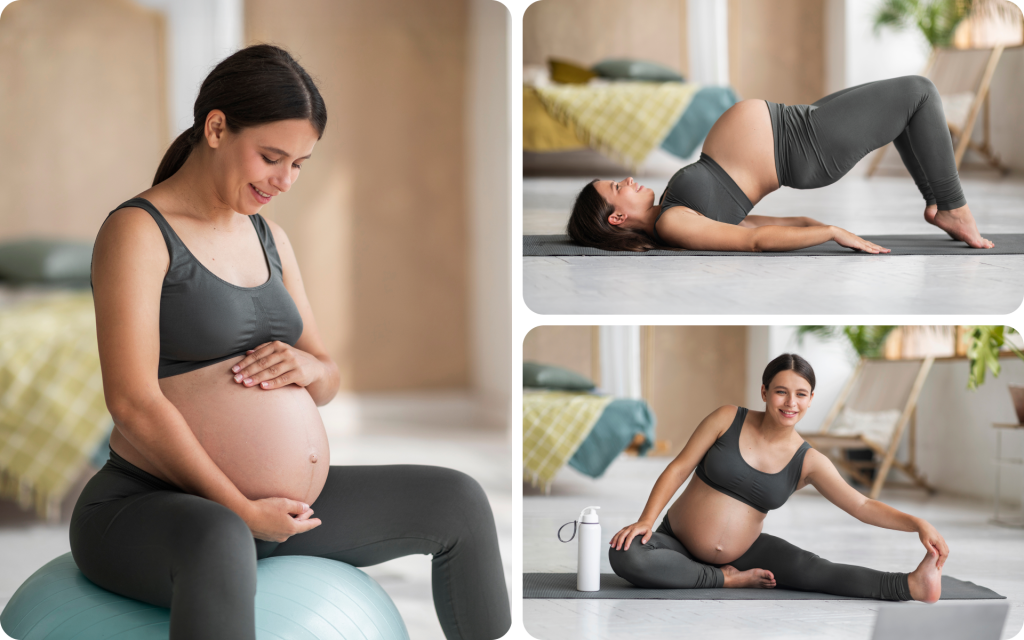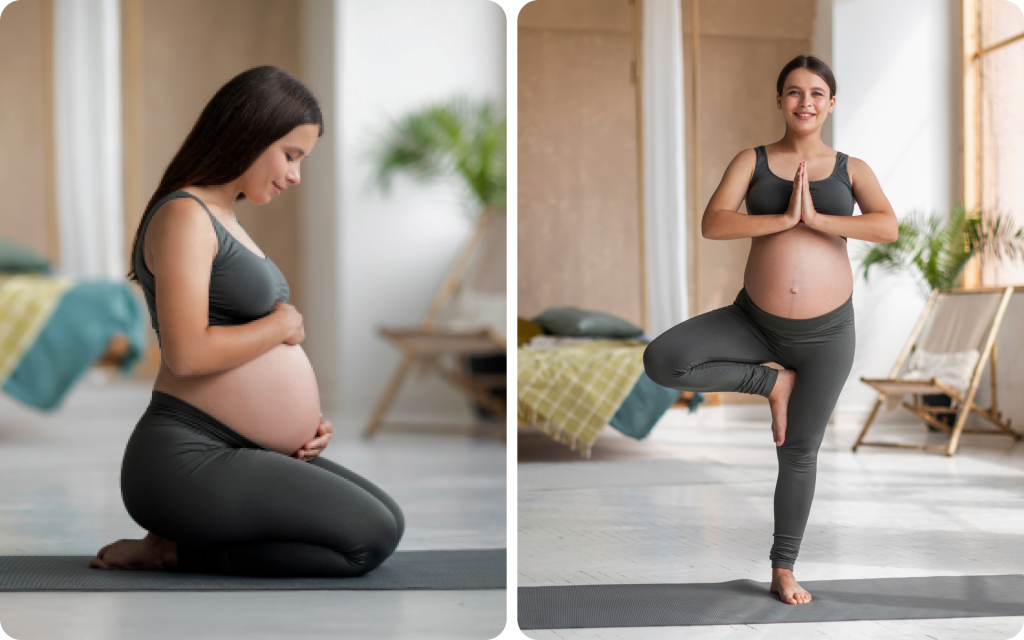The realization that you’re pregnant comes with a myriad of emotions. To some, the news is met with immense joy, while to others, sheer panic is the best way to describe how they feel about this news.
Once the initial feelings settle, the next step is often confusion about what needs to change in the next couple of months as you get ready to have your baby. How you exercise is one of the many changes that must occur.
Here’s everything you need to know about exercising while pregnant and tips for a safe and effective pregnancy workout plan.
Can You Exercise During Pregnancy?
Yes, you can exercise during pregnancy. Traditionally, women were advised not to engage in exercise as it was believed that it would cause harm to them and their unborn fetuses.
However, thanks to scientific research, we now know this to be untrue. Research has shown that women can work out while expecting and having a pregnancy workout plan and doing the workouts is beneficial to both mother and child.
How Intensely Should You Exercise While Pregnant?
While there is a general consensus that it’s good for women to exercise while pregnant, the ideal level of intensity of physical activity remains contested.
While most studies and experts state that moderate-intensity exercises are the way to go (1, 2, 3), some claim that pregnant women can engage in high-intensity/vigorous workouts and that they pose no risk.
Those who advocate for intense exercise claim that it’s relatively safe during the last trimester or throughout the pregnancy if they habitually engaged in vigorous-intensity aerobic activity or were physically active before the pregnancy (4, 5).
As pregnancy is a delicate time in a woman’s life, we recommend that you speak to your doctor or OB/GYN to see which option best suits you.
What Are Some Benefits of Exercising During Pregnancy?
Research has stated that despite recommendations from physicians to start or maintain an exercise program during pregnancy, only about 40% of patients exercise. The remaining 60% lead a sedentary lifestyle, which comes with many health risks.
If you’re looking for that extra push to get up and work out while pregnant, here are some benefits that you could expect
- Reduced Risk of Deep Venous Thrombosis
A condition caused by both pregnancy and prolonged immobility where blood clots form deep in the veins of the legs, pelvis, or arms that can be life-threatening to both mother and child (3).
- Reduced Risk of Obesity
Obesity is bad whether a person is pregnant or not.
However, obesity is said to carry an elevated risk of major complications for expectant mothers such as spontaneous abortions, gestational diabetes, preeclampsia, sleep apnea, macrosomia, preterm birth, and even stillbirth.
The fetus of an obese mother or one with a higher BMI is also at a higher risk of neural tube defects, which include cleft palate, spina bifida, and hydrocephalus (3).
Reasons why BetterMe is a safe bet: a wide range of calorie-blasting workouts, finger-licking recipes, 24/7 support, challenges that’ll keep you on your best game, and that just scratches the surface! Start using our app and watch the magic happen.
- Reduced Risk of Excessive Gestational Weight Gain
You’ll gain weight when pregnant – that’s an inescapable reality. However, working out can help control the amount of weight you gain, which reduces the risk of obesity and lowers the risk mentioned in point 2 above (6, 7).
- Improved Mental Health
In a systematic review published in early 2019, researchers found that physical activity helped prevent and reduce symptoms of depression in expectant women and was also impactful in reducing levels of anxiety and stress, in addition to improving their overall quality of life (8).
- Can Help Shorten the Duration of Labor
In a study involving 588 healthy pregnant women (253 in a control group and 255 in the exercise group), researchers found that engaging in a three-times-a-week moderate aerobic exercise program throughout pregnancy led to reduced total labor time in the women in the exercise group (9).
Read more: Pregnancy Cardio Workout: Everything You Need to Know to Do It Safely
Can I Get in Shape While Pregnant?
Yes, you can get in shape while pregnant, but this isn’t particularly the best time to be considering the possibility of weight loss.
If you’re overweight and hope to get in shape or at least lose some pounds before your baby comes, we suggest that you first speak to your doctor before you change your lifestyle or diet.
As previously mentioned, this is a sensitive time for you and your growing baby and any changes may be dangerous for you both. Remember that:
- A calorie deficit, which is essential for weight loss, isn’t the best option at this time.
In fact, you may have to eat more calories than usual. According to the Dietary Guidelines for Americans 2020-2025, calorie needs during the first trimester of pregnancy generally don’t increase compared to pre-pregnancy needs. However, during the latter trimesters and lactation, women need an extra 300 to 400 calories (10).
- Intense exercise that contributes to weight loss is perhaps not the best option.
As seen above, most studies and experts recommend moderate-intensity exercises during this time. Engaging in high-intensity workouts may put you and your baby at risk
- You’re more likely to gain weight not lose it while pregnant.
While the rate of gestational weight gain varies – some say pregnant women gain between 10kg and 12.5kg (22lb to 28lb) while others say 11lb to 20 lb (11, 12) – it’s generally known that weight gain is to be expected.
Due to all these factors, it’s probably best to hold off weight loss until you’ve given birth to your baby. Please note that you can still exercise and eat healthily to prevent excessive gestational weight gain.
Read more: 7-Week Pregnancy Diet: How to Get the Best Nutrition for You and Your Baby
How to Tone Your Body While Pregnant
Resistance training and strength training are great examples of exercises that should be in an expectant woman’s pregnancy workout plan to help tone her body and muscles. She can choose to go to the gym and work out alone or with a trainer or simply do such workouts at home with just her body weight, at-home free weights, or resistance bands.
In addition to resistance/strength training, other forms of exercise that are recommended during this time include yoga, Pilates, cardiovascular exercise such as walking, cycling, stair steppers, ellipticals, swimming, and aerobic dance, and lumbar stabilization and nerve and tendon-slip exercises (1, 3).
How to Avoid a Big Belly During Pregnancy
Avoiding a big belly during pregnancy goes back to your nutrition and level of physical activity as it’s related to weight gain. Increased physical activity helps burn extra calories, which enables you to prevent excessive gestational weight gain.
In terms of nutrition, you should focus on a balanced diet that’s rich in whole grains, lean animal proteins, and a variety of plant protein, healthy fats, lots of leafy greens and non-starchy vegetables, moderate starchy vegetables, and lots of fruit. Eating healthily is good for your health and that of your baby and it also reduces the risk of a big belly and obesity, which as we’ve seen above, can lead to major pregnancy-related complications.
Which Month Is Best to Exercise During Pregnancy?
There is no singular month that stands above the rest as the best month to work out while expecting. As mentioned above, expectant women can and are encouraged to remain active throughout their pregnancy by engaging in moderate-intensity aerobic, stretching, and strength-training workouts.
Be sure to speak to your doctor or OB/GYN to better understand which exercises to engage in and avoid regarding your body and how your pregnancy is progressing.
Pregnancy Workout Plan for the First Trimester
During the first trimester, you should aim to establish good exercise habits and gradually ease into them. Also, remember that the amount of exercise you do will depend on how active you were pre-pregnancy and what your doctor advises.
Here are some targeted exercise suggestions to perform during your first trimester:
Pelvic Floor Exercises
Your pelvic floor muscles are probably the most important muscles to strengthen as they stretch during pregnancy and childbirth. The following exercises are recommended:
Kegels
Kegel exercise helps strengthen muscles that support abdominal organs such as the vagina, bowel, bladder, and uterus. You need these muscles in top shape to assist during labor and avoid postpartum incontinence (13).
- Empty your bladder, then sit or lie down.
- Tighten your pelvic muscles (which are the same ones you use to stop urine flow), holding tight for 3 to 6 seconds.
- Relax for about 5 seconds.
- Repeat 8 to 10 times, three times per day.
Pro Tips:
- Relax when doing this exercise. Ensure you’re not tightening your thigh, buttock, or stomach muscles.
- Avoid practicing kegels while urinating as this may weaken your pelvic muscles over time and cause damage to your bladder.
Bodyweight Squats
Squats are a great resistance exercise to help build and maintain strength in the hips, pelvic floor muscles, and glutes. When done correctly, squats can help improve your posture, and squatting during delivery may help ease the birthing process (14).
- Find level ground and stand with your feet shoulder-width apart.
- Hold your arms straight out in front of you.
- Slowly lower yourself into a squat position. You can go as low as you feel is comfortable as long as you keep your back straight and your weight firmly on your heels.
- Return to a standing position, squeezing your glutes on the way up.
- Repeat this 10 to 20 times, or as many times as your body is comfortable with.
Squat to Reverse Lunge
- Stand with your feet hip-width apart and your toes facing forward.
- With your chest high and knees behind the toes, slowly bend both knees until your thighs are parallel to the ground. Alternatively, bend as low as you feel comfortable.
- Extend your legs to the back while you squeeze your butt, then slowly return to a starting position.
- To perform a reverse lunge, take a step back with your left foot and bend both knees to a 90-degree angle.
- Alternate sides and do a rep for 5-10 lunges.
Kickbacks
- Get on all fours on the carpet or on your exercise mat. Ensure it doesn’t slip. Also, make sure your palms are flat and straight beneath your shoulders.
- Lift your right leg straight up behind you and keep your stomach muscles engaged and your spine straight.
- Return to the starting position, then do the same with your left leg. Again, perform as many reps as you feel comfortable with.
Tip: To increase the intensity of this exercise, pulse the heel of your extended leg before you switch.
Caution: Avoid doing too many reps as you may strain your stomach muscles.
Core Exercises
You need a strong core to help carry your pregnancy comfortably. A weak core puts you at risk of severe lower-back pain (15). On the other hand, a strong core will help provide much-needed support for the growing baby. Planks are a great example of core workouts that pregnant women can do in the first trimester.
Cardio Exercises
Cardio exercise helps keep your heart muscles in check and also maintains a healthy weight during pregnancy. In addition, reduced stress and anxiety have also been linked to cardio exercises (8).
Some cardio exercises you can try include running and jogging, cycling, and swimming.
Pregnancy Workout Plan for the Second Trimester
As you progress into the second trimester, your pregnancy will become more noticeable. The changes in your body will become more prominent. You may find it difficult to do some of the exercises you did in the first trimester. Although the second trimester usually comes with an energy burst, your growing tummy may limit the kind of exercise you can do. Example workouts you can do during this time include:
- Deep belly breathing, aka diaphragmatic breathing, which can help with pelvic floor strength (16)
- Lower body workouts such as sumo squats, lunge variations, etc.
- Cardio exercises such as walking, step jacks, and swimming
BetterMe: Health Coaching app is a foolproof way to go from zero to a weight loss hero in a safe and sustainable way! What are you waiting for? Start transforming your body now!
Pregnancy Workout Plan for the Third Trimester
The third trimester is usually characterized by a protruding belly, reduced energy levels, and general body fatigue. You need to take extra caution when exercising during this home-stretch trimester.
The body changes associated with pregnancy may limit you when it comes to exercise. Your body is pushed to its limit at this point, and activities such as sleeping and walking become challenging. You’re constantly exhausted, the trips you make to the loo are countless, and labor and delivery are constantly on your mind.
Despite all this, exercise is still an essential part of your routine. In addition, physical activity may help alleviate some of the nasty symptoms you face. At this point, you should keep up with the pelvic floor, lower body, and cardio workout routine.
The only thing we would suggest is that you should modify the workouts to better suit your current state as the previously mentioned larger belly and increased fatigue can hinder many movements.
What Exercise Isn’t Safe During Pregnancy?
While pregnant, women are cautioned to avoid exercises or activities with (2, 17):
- A high risk of trauma or injury, particularly those that have a high risk of direct abdominal trauma. This includes contact sports such as martial arts, soccer, hockey, and basketball.
- A high risk of sustaining a significant fall such as downhill or water skiing, surfing, off-road cycling, gymnastics, and horseback riding.
The Bottom Line
Exercising during pregnancy is necessary for your and your baby’s overall well-being. Prenatal exercises help ensure your baby is born healthy and that you’re in a physical and mental state to bring your baby into the world safely.
Having a workout plan for pregnancy makes it easier to stay committed to your fitness journey. You can make the plan at home or better yet, involve a professional to tailor the plan to fit your pregnancy journey and unique needs.
Remember that a fit mum results in a fit, happy baby, so start exercising today.
DISCLAIMER:
This article is intended for general informational purposes only and does not serve to address individual circumstances. It is not a substitute for professional advice or help and should not be relied on for making any kind of decision-making. Any action taken as a direct or indirect result of the information in this article is entirely at your own risk and is your sole responsibility.
BetterMe, its content staff, and its medical advisors accept no responsibility for inaccuracies, errors, misstatements, inconsistencies, or omissions and specifically disclaim any liability, loss or risk, personal, professional or otherwise, which may be incurred as a consequence, directly or indirectly, of the use and/or application of any content.
You should always seek the advice of your physician or other qualified health provider with any questions you may have regarding a medical condition or your specific situation. Never disregard professional medical advice or delay seeking it because of BetterMe content. If you suspect or think you may have a medical emergency, call your doctor.
SOURCES:
- Physical activity during pregnancy: a systematic review for the assessment of current evidence with future recommendations (2022, bmcsportsscimedrehabil.biomedcentral.com)
- High-intensity exercise during pregnancy – A position paper by the European Board and College of Obstetrics and Gynaecology (EBCOG) (2023, ebcog.eu)
- Pregnancy And Exercise (2023, ncbi.nlm.nih.gov)
- The effects of vigorous intensity exercise in the third trimester of pregnancy: a systematic review and meta-analysis (2019, bmcpregnancychildbirth.biomedcentral.com)
- WHO guidelines on physical activity and sedentary behaviour (2020, iris.who.int)
- Impact of exercise during pregnancy on gestational weight gain and birth weight: an overview (2018, pmc.ncbi.nlm.nih.gov)
- Physical activity and pregnancy outcomes: An expert review (2023, pmc.ncbi.nlm.nih.gov)
- Physical Activity and Depressive Disorders in Pregnant Women—A Systematic Review (2019, pmc.ncbi.nlm.nih.gov)
- Exercise during pregnancy is associated with a shorter duration of labor. A randomized clinical trial (2018, pubmed.ncbi.nlm.nih.gov)
- 2020-2025 Dietary Guidelines and Online Materials (n.d., dietaryguidelines.gov)
- Weight gain in pregnancy (2022, nhs.uk)
- Weight gain during pregnancy: A narrative review on the recent evidences (2022, sciencedirect.com)
- [Effect of Kegel exercise to prevent urinary and fecal incontinence in antenatal and postnatal women: systematic review] (2013, pubmed.ncbi.nlm.nih.gov)
- The effects of squatting while pregnant on pelvic dimensions: A computational simulation to understand childbirth (2019, pubmed.ncbi.nlm.nih.gov)
- The effects of core and lower extremity strengthening on pregnancy-related low back and pelvic girdle pain: a systematic review (2012, ncbi.nlm.nih.gov)
- Effect of diaphragm and abdominal muscle training on pelvic floor strength and endurance: results of a prospective randomized trial (2019, pmc.ncbi.nlm.nih.gov)
- Exercise in pregnancy (2023, nhs.uk)











